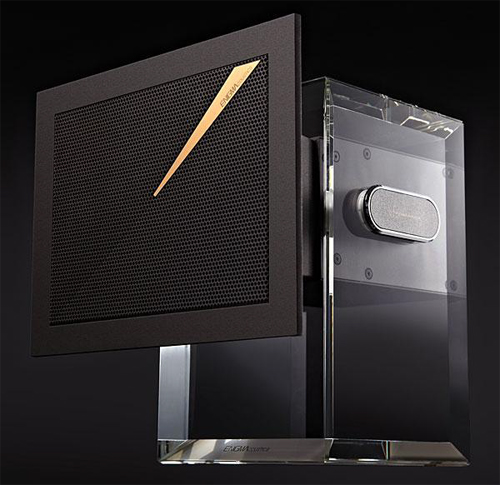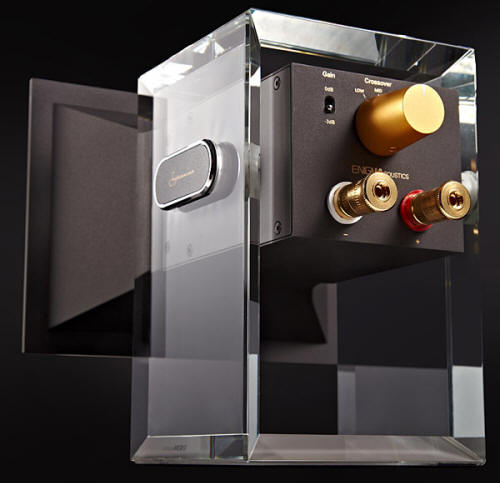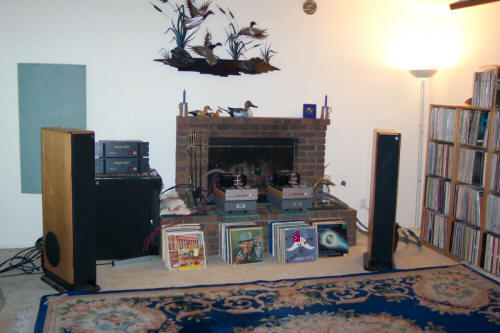|
|
You are reading the older HTML site
Positive Feedback ISSUE 73
enigmacoustics Sopranino Electrostatic Super Tweeters as reviewed by Roger S. Gordon
When audiophiles are asked what is the ideal sound that they want to create in their listening room you will get many answers. Some people want thundering bass. Others want a midrange where the female vocals melt your heart. Other audiophiles want a light, spacious top end. Obviously, a system that can deliver all three of these attributes would be a wonderful audio system. Unfortunately, any audio system is a compromise. Loudspeakers are even more of a compromise. Getting that right combination of powerful bass, gorgeous midrange, and sparkling, spacious highs is both difficult and many times expensive. Even if a person has an audio system that plays gorgeous music and has a flat frequency response from 20 to 20kHz in an anechoic chamber, the sound in that person’s own listening room may not be so spectacular. For example, rooms can be over damped with lots of carpeting and overstuffed furniture. This can suck the life out of the high frequencies. Or a person could be of increasing maturity and his hearing, particularly at the higher frequencies, is diminished. So, even with a perfect audio playback system a person might not be getting the full auditory experience. So what is an audiophile to do? In the old days, preamplifiers came with tone controls. If you were not hearing a bright, sparkly top end you would turn up the treble until you did. For various reasons, tone controls fell out of favor with audiophiles. In lieu of treble controls some loudspeaker manufacturers started adding ambiance tweeters to their products. These tweeters, usually operating above 5kHz, were aimed at the rear or side walls or occasionally the ceiling. Some of those tweeters were moveable so that you could rotate them and tune the ambiance to your preference. This extra high frequency energy being reflected off of the walls and ceiling did add additional air and space to the sound. When VMPS Loudspeakers brought out an inexpensive pair of ambiance tweeters I bought a pair for my VMPS RM30 speakers. Wired in parallel to the treble speaker binding posts the small ambiance tweeters did add a little extra sparkle to the top end. There have been many other add-on ambiance tweeters sold over the years by both loudspeaker manufacturers and others. However, until now there has been nothing like the EnigmAcoustic’s Electrostatic Supertweeter;. a.k.a. Sopranino.
The Sopranino is an electrostatic supertweeter. The Sopranino is relatively small with a weight of 6lbs or 2.7 kg and dimensions (w x h x d) of 7 1/4 x 7 5/8 x 8 1/8 inches or 181 x 193 x 207 mm. The Sopranino units can be placed on top of the main speakers or on separate stands. The Sopraninos do not need a separate power supply or special cabling. Just connect the Sopraninos to the binding posts of the main speaker with speaker cables. Correct positioning of the Sopraninos is important. Electrostatic speakers are beamy and the Sopraninos are no exception. Initially, I tried placing the Sopraninos on top of my JansZen zA2.1 speakers. I tried various combinations of tilt and direction, but I was not satisfied with the results. I ultimately set the Sopraninos on 34" monitor stands just to the outside of the JansZens. In my room, this is where they sounded the best. Your mileage may vary. Having properly positioned the Sopraninos I next started to experiment with the different control settings. The Sopraninos have two volume levels 0dB and -3dB with a nominal sensitivity of 90dB at 2.82V input. If your main speakers have lower sensitivity you may need to use the -3dB setting to properly match the output between the Sopraninos and your main speakers. I used the 0dB setting. The other control on the Sopranino is the crossover point. This is where you select the frequency at which you want the Sopranino to start augmenting the output of your main speakers. You can select a cutoff frequency of 8kHz, 10kHz, or 12kHz. According to the Sopranino literature, the supertweeters have a frequency response of 8kHz - 40kHhz (+/- 3dB). I have no way of either hearing or testing frequency response above 20kHz. However, I ran some room frequency sweeps from 20Hz to 20kHz on each of the three settings. For all three settings the Sopraninos start at the cutoff frequency and then gradually rise until by 20kHz they are up 3-6dB depending on which gain setting (0dB or -3dB) and cutoff frequency you were using. By trying different combinations of gain and cutoff you will find a combination where the Sopraninos sound most pleasing to you. In my system and in the systems of my friends who borrowed the Sopraninos from me, the Sopraninos blended in perfectly with the main speakers regardless of the control settings.
So, with the Sopraninos properly positioned and the control settings set you to your preferences what do you hear? It depends. I had two groups of people from our local audio society come over to listen to the Sopraninos in my system. Everyone heard a difference when the Sopraninos were switched in and out of the system. Everyone felt that the system sounded better with the Sopraninos in the system. Where people differed was in the extent of the difference they heard. Some people were blown away—"Wow. This is incredible" was what one person said. Other people said the difference was nice but it was not the life changing event the others thought it was. When I lent out the Sopraninos to friends there was a similar response. One person wanted to buy the Sopraninos and the other person thought what the Sopraninos did was very nice but not enough that he wanted to buy them. From my own listening to the Sopraninos I agree they add additional air and sparkle to the top end which is very pleasing to my ears. My JansZen zA2.1 speakers already have a rising top end and are about +3dB at 20kHz. With the Sopraninos and my JansZen speakers playing the frequency response in my room is +6dB at 20kHz. According to Wei Chang, sales manager for ENIGMAcoustics, psychoacoustic studies have shown that in general people like the sound of lots of energy at the top end up to a maximum of about +12dB. I don’t know about +12dB, but at +6dB I found the sound to be preferable to the +3dB of my JansZen speakers alone. Conclusion The Sopraninos perform as advertised. They are a supertweeter that seems to blend in very easily with different audio systems. Visually, they are eye candy and can be placed in mega buck systems without looking out of place. And most importantly, the Sopraninos do provide additional energy at the top frequencies which I and my fellow listeners interprete as additional air, space, and sparkle. We all found these additions to be improvements. If you are looking for something to add some life, some zing to your top end you really need to audition a pair of the Sopraninos in your own system. They are really remarkable. Roger S. Gordon
Sopranino Super Tweeters
EnigmAcoustics
|











